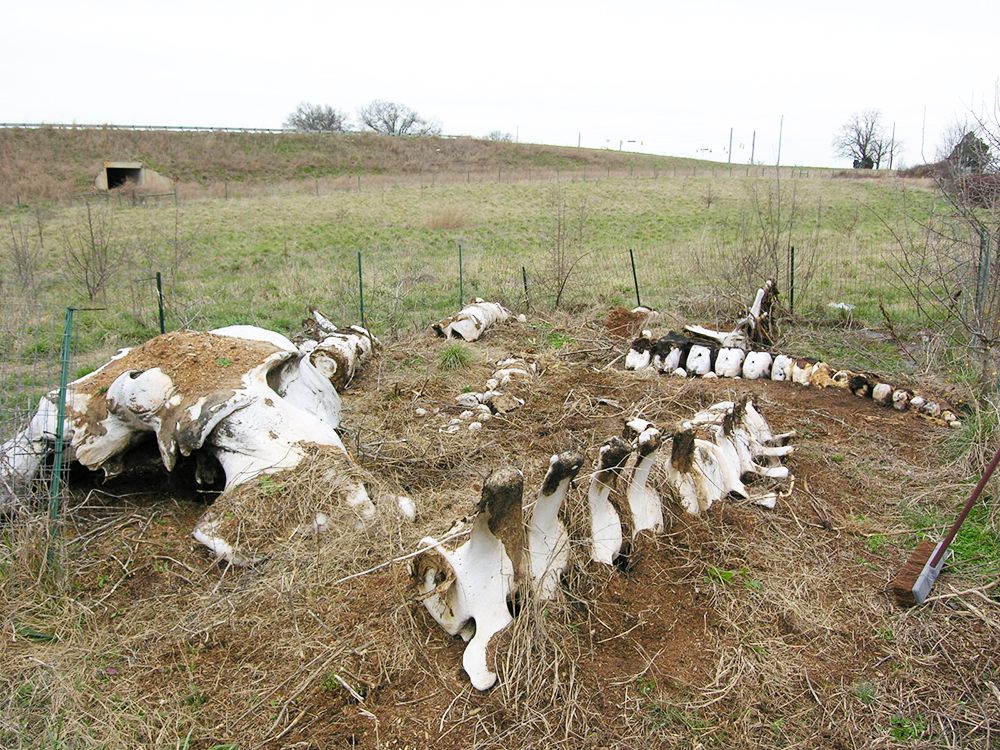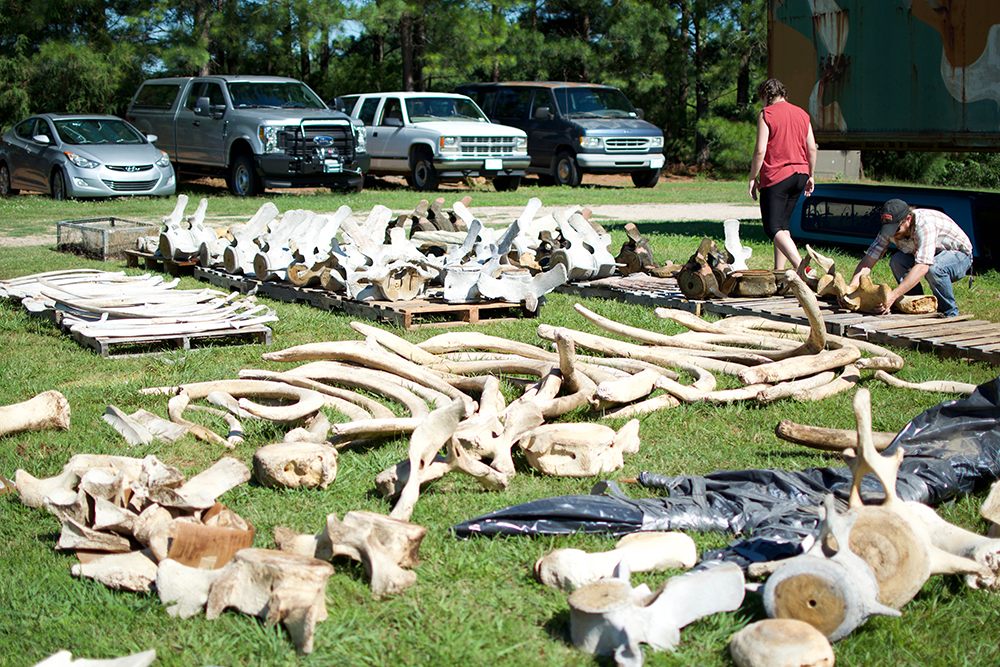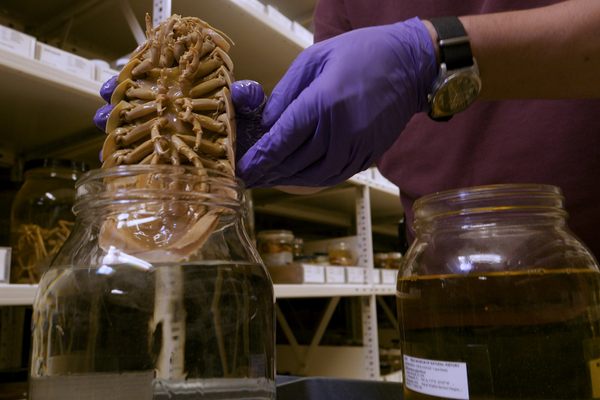Why a Local Museum Keeps Burying Whales Under Raleigh, North Carolina
It mostly has to do with grease.

Just down the road from North Carolina’s cosmopolitan state capital, there is a field. In that field, there is an enormous mound of dung. And buried under that dung, more than a hundred miles from the nearest beach, are the colossal bones of a whale.
For years, Raleigh has served as a burial ground for these massive mammals. From the behemoth 54-foot sperm whale inhumed in sand on the State Fairgrounds back in the 1920s to the right whale buried in manure five miles from downtown this summer, Raleigh has become the unlikely—if only temporary—resting place of dozens of marine mammals over the last century, although the exact number is unknown.
But apart from thoroughly confusing future archaeologists, what possible reason could there be for burying these whales? Ben Hess of the North Carolina Museum of Natural Sciences explains that it mostly has to do with grease.


Hess is the museum’s Mammalogy Collections Manager. As such, he is charged with processing the mammals that get sent to the museum so they can be used for biological research. In come dead rats and rabbits, out go clean skins or bones that get added to the museum collection, where researchers from all over the world can study them. Hess has prepared all kinds of mammals—wolves, bats, bears. You name a furry, warm-blooded creature of the southeastern United States and Hess has probably held its heart in his hands or cleaned its body in his box of corpse-munching dermestid beetles, also known as “skin beetles.” It’s all part of the job.
But every now and then, Hess is tasked with preparing a specimen that won’t fit in his box of beetles, or even the double-wide doors of the museum. On those occasions, when a whale washes up on the North Carolina shore that the museum wants for the collection, it’s Hess and the rest of the Mammalogy team that must turn it from a fetid leviathan of fat and bone into a clean specimen. To do so, they just need a mountain of horse dung and a spot of land near the museum’s downtown Raleigh location.

Walking past the mound of manure, you’d never know what was hiding beneath it. The pile sits in a small field surrounded by a chain-link fence, which Hess says keeps the coyotes away. A few flies busy themselves in the excrement and you can hear cars whizzing by on the highway. Poking out here and there is a bit of white, betraying the location of a piece of skull the size of a pickup truck bed.
“[The skeleton] just had a little connective tissue, and unfortunately because of how porous the bone is, if you tried to pry it off you’re really going to break the bone apart,” Hess tells me, sitting in his laboratory, stuffing a black rat with cotton. Instead, the team uses the organisms naturally living in horse manure to scrub the bones clean of the remaining tissue and grease.

“People often say ‘oh, it’s the worms and stuff’ but nope, that’s not what happens,” explains the museum’s Mammalogy Research Curator Lisa Gatens. “It’s composted. It’s anaerobic decomposition, so it’s the bacteria in the manure that cleans it.” That bacteria eats off the skin, muscle, and, of particular importance, the grease percolated deep inside the porous bone.
“[Horse manure] does a fantastic job of de-greasing bones,” says Hess. “There’s really very little that can compare to how good that does.” That manure is sourced for free from a North Carolina State University horse farm just down the road. “They have an ample supply of poop and we have an ample supply of need,” quips Hess. After being buried in the feces, the bones emerge, sometimes years later, thoroughly clean. Then, all it takes is a quick soap scrub and the bones can be deposited in the collection or articulated into a giant skeleton to go on display in the museum.
This history of burying whales in Raleigh goes back to at least 1928 when then-Museum Director H. H. Brimley sent a team down to the coastal town of Topsail, North Carolina, to carve up a beached sperm whale. The monumental task, somehow accomplished in waist-deep water using only axes and spades, raised more than a few eyebrows among residents, as described in an article from the museum’s archive.
“An unsigned letter given to the press expressed strong resentment of ‘the parking of a uzed [sic] whale’. Residents, the letter further explained, ‘would suffer if the intent of beaching the Jonah at Topsail is carried out. It’s poor policy to throw your trash in your neighbor’s backyard.’”
Eventually, the whale bones were hauled up to Raleigh’s State Fairgrounds, where “Trouble,” who was named for the hassle his decaying body caused, underwent a 10-month cleansing soak in wet sand before being brought to the museum. But the fairgrounds quickly proved to be a poor site for cleaning whale skeletons due to the annual gathering of thousands of people every fall. So after Trouble the operation moved to a different spot just outside the city beltline.

Right whales, pilot whales, and even a few rare True’s beaked whales were all processed at this second spot. Like Trouble, each whale was carved up on the beach (a task undertaken in recent times by North Carolina’s Marine Mammal Stranding Network) to separate as much flesh from the skeleton as possible. Then the whale bones were trucked up to the new location to be buried in purifying baths of sand, and later, horse manure.
Today that land is the site of the Wake Med Soccer Park, where the North Carolina FC professional soccer team plays its games. A spokesman for the soccer club was “surprised” to learn of the land’s prior use. And you can’t blame him. Sitting in the stadium above the perfectly manicured grass, it’s hard to imagine the land was once used to process the bones of beached marine mammals.

Around the year 2000, the operation moved a final time to the latest site. One of the first whales buried here was a critically endangered 50-foot northern right whale named Stumpy. She and her unborn calf were covered in manure for a year and a half after they washed up dead on the North Carolina shore. Her bones, broken from ship strikes, were later used to inform new policy on boat speeds in right whale habitat, clearly demonstrating the value of preparing these specimens for the collection.
Mary Kay Clark was the museum’s Curator of Mammals before Gatens. In an email she writes, “[I]t would never occur to Raleigh residents that the remains of some of our most interesting NC coastal residents are nearby.”

But that’s the thing about a place’s past. The earth has a long and dynamic history and even the most unassuming of locations can be hiding incredible secrets. Indeed, when ocean levels were higher at various times in North Carolina’s geologic history, the skeletons of marine animals likely washed up near Raleigh. So in a sense, these whales aren’t anything new—they’re the continuation of the long legacy of a landscape whose history is waiting just under the surface to be explored.

















Follow us on Twitter to get the latest on the world's hidden wonders.
Like us on Facebook to get the latest on the world's hidden wonders.
Follow us on Twitter Like us on Facebook